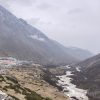Wednesday, May 29, 2024
News and Views from the Global South
Water & Sanitation
Back to Nature to Avoid Water Collapse in the Capital of Chile
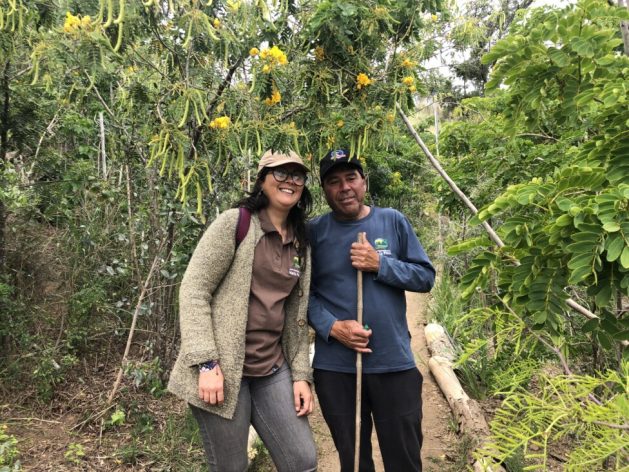
María José Valenzuela, Director of the Environment of the Chilean municipality of María Pinto, stands next to Mario Rojas, caretaker of the Miyawaki project, a pilot experience of this technique that works with little water and only requires irrigation for the first two years. A native forest has been created that improves the biodiversity of the area, in a municipality that defines itself as sustainable. CREDIT: Orlando Milesi / IPS
- A return to nature is the main solution being promoted by communities and municipalities to avoid the water shortage that threatens to leave Santiago, the capital of Chile, home to more than 40 percent of the 19.5 million inhabitants of this South American country, without water.
The water supply in Greater Santiago depends on the Maipo River, whose waters run for some 250 kilometers from the Andes Mountains to the Pacific Ocean, near the port of San Antonio, some 130 kilometers north of Santiago.
In the Andes mountains, the Volcán, Yeso and Colorado rivers are tributaries of the Maipo River. The Maipo ranks ninth among the 18 most water-stressed rivers in the world and is the only South American river in this ranking.
Chile is experiencing an unprecedented drought that has dragged on for 15 years, caused by climate change and other phenomena such as El Niño and La Niña.
This year 2023 there was more rainfall. The Maipo even flooded and caused turbidity in the water and all the outlying districts were threatened with a total lack of supply for three days. But the authorities warn that the drought is not over and are preparing contingency plans to cope with its increasing effects now that the southern hemisphere summer is approaching.
Of the groundwater wells measured in Santiago and its surrounding region, 72 percent show a significant decline because extraction exceeds the natural recharge capacity.
In the basin, the current water gap – the difference between available water supply and demand – is 63.5 cubic meters per second. But by 2050, the water gap will be 92.1 cubic meters per second, if demand does not increase.
This water stress is caused by the high summer temperatures and rainfall that is scarce and concentrated in a short period of the winter, which has been happening since the onset of the current drought in 2008.
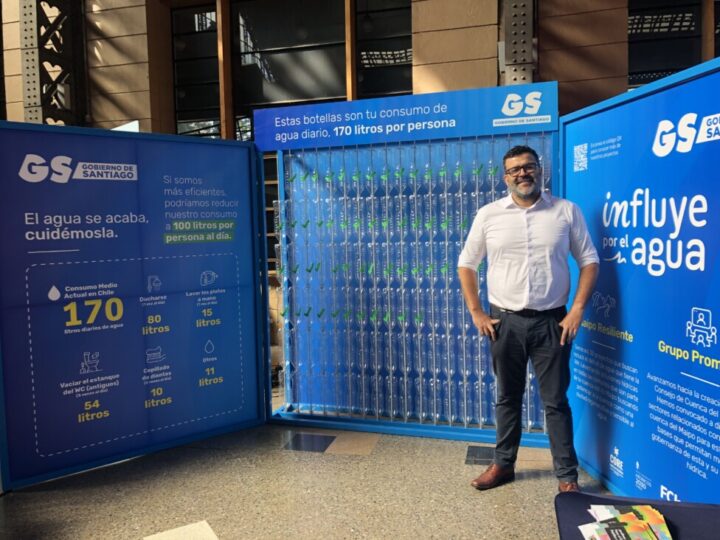
Gerardo Díaz of the Chile Foundation mans a stand set up at the Mapocho Station Cultural Center in Santiago, during a public event to educate and raise awareness about the need to take care of household water. Banners explain the water crisis and illustrate ways to deal with it. CREDIT: Orlando Milesi / IPS
According to Water Scenarios 2030, an innovative initiative promoted by the Chile Foundation, in a collaborative effort with different stakeholders, water efficiency would contribute 73 percent of water within the set of solutions for this basin, while the conservation and protection of its ecosystems would contribute 18 percent.
The incorporation of new water sources would contribute nine percent to the solution, but requires an excessively high investment, says the study led by the Chile Foundation, a public-private organization dedicated to working for sustainable development.
These studies indicate that in the basin there are 35 percent more groundwater rights granted than the natural recharge capacity of the aquifer. This overexploitation has repercussions on the availability of groundwater in the present and the future.
Gerardo Díaz, head of projects at the Chile Foundation’s sustainability department, told IPS that no solution has been ruled out, but said “we are focusing on looking at how nature and strengthening natural water systems can help us resolve the crisis we are in.”
IPS visited several localities in Greater Santiago, which is made up of 52 municipalities, to observe some nature-based solutions and the water improvement they bring.
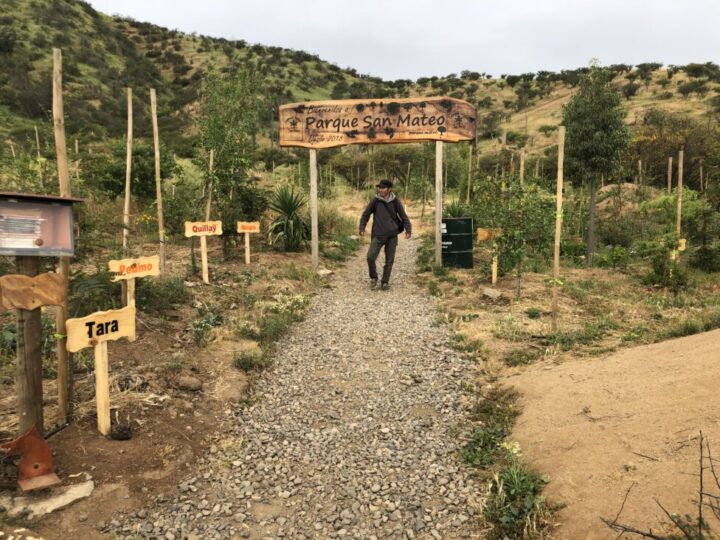
Fabian Guerrero, director of the San Mateo Park in the Chilean municipality of Curacaví, walks through the 14-hectare open space in the center of town that was once a garbage dump where the trees have signs identifying their species and the trails are marked for visitors. Five compost bins operate on site to receive organic matter that is turned into compost to nourish the gardens, trees and seedlings. CREDIT: Orlando Milesi / IPS
Miyawaki technique to grow trees in rural municipality María Pinto
In the rural municipality of María Pinto, with a population of 14,000 people, located 40 kilometers from the center of Santiago, a technique created by Japanese botanist Akira Miyawaki, which accelerates the growth of native forests by up to 10 times, was successfully implemented for the first time in Chile. Trees are planted at low density in soil fertilized with nutrients.
It is a method of ecological restoration based on the potential natural vegetation of a given area, reproducing in an accelerated manner the landscape that would exist if there had been no human presence and turning it into a refuge for native biodiversity and its many different forms of life.
“We are carrying out an ecological restoration of the hillside to replace a 40-year-old radiata pine plantation that dried out due to a plague,” María José Valenzuela, the municipality’s environmental director, told IPS.
The restoration was carried out on one of the seven hectares of the San Pedro Sports Field and involved numerous volunteers from the Liceo Polivalente, a municipal high school, who called themselves Forjadores Ambientales (roughly, environmental creators).
Forests generate conditions for greater water infiltration for the trees, which are also fog trappers. And they help to prevent rainwater from running off quickly and to infiltrate the soil instead.
“Global warming is manifesting with more fog and that is something that is noticeable,” Valenzuela explained.
Campo San Pedro also points to a problem with the hillsides in the center of this long narrow country, which arises from monoculture farming.
The Miyawaki lot now has 3500 trees of 10 native species on 500 square meters.
It functions as a laboratory of sclerophyllous forest, typical of Chile, where the Miyawaki technique provides an example for recovery of the remaining forests in central Chile. This kind of forest is characterized by species with hard evergreen leaves that enable them to withstand droughts.
“Many monoculture farms after exploiting the wells leave hills converted into deserts, with infertile soil due to so many agrochemicals and all the times they were plowed and not covered,” explained Valenzuela, a civil engineer specializing in sustainability and social ecology.
She was alluding to the repeated abandonment of hillsides in central Chile that are dedicated to monoculture, mainly avocado and fruit trees, and then deserted when they become wastelands due to lack of water.
In Chile, agriculture accounts for more than 60 percent of water consumption, in a country with a dynamic agro-export sector that expanded with few controls.
And as in most of Chile’s rural areas, the municipality is full of “loteos”, the name given locally to divisions of land without infrastructure services or regulatory plans. Added to this are the sale of water rights and the excessive use of water by digging irregular wells to fill swimming pools or maintain lawns.
In this country, water has been largely privatized after water rights were separated from land tenure during the dictatorship of Augusto Pinochet (1973-1990). This resulted in water rights being traded on the market as a commodity, restricting public access to water.
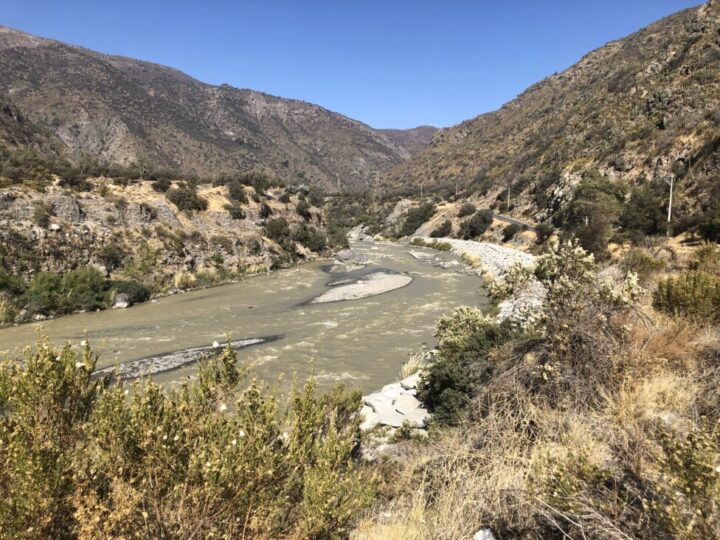
Nearly 40 percent of Chile’s population lives in the Maipo River basin, because it is home to Greater Santiago and its 52 municipalities. A new study warns that it is under maximum pressure, while the inhabitants have little awareness about the stress of their drinking water supply. CREDIT: Orlando Milesi / IPS
Ecological recovery in Curacaví
In the rural municipality of Curacaví, 53 kilometers from downtown Santiago and home to 33,000 inhabitants, the community mobilized in 2018 to recover 14 hectares of hillside that had turned into an open-air landfill.
Alarmed by a fire, in January of that year local residents removed 50 tons of garbage and organized themselves in the San Mateo Park to reforest and plant, to date, 5,000 native trees.
Fabian Guerrero, general director of the park, told IPS that the municipal government provides them with 40,000 liters of water per week. It also supplies machines to remove the soil, and to use guano (the excrement of seabirds) and organic matter to prepare a Miyawaki forest with native species planted at high density in a small space.
“We have drip and sprinkler irrigation techniques to use water efficiently. In the park there are organic vegetable gardens, compost bins, trails and guided tours for students and families, to whom we teach how and which trees to plant, in which location, which one gives more shade or withstands more sunshine,” he told IPS.
The community won seven reforestation projects and their dream is two other initiatives: to have their own water, with a dam or pond, and to create a nursery with all kinds of trees, medicinal plants, vegetables and flowers.
“We plan to create a green lung so that people see this place as a space for family recreation, connected to nature, a place to come and reflect and learn about trees. We aim for education and for people to learn to take care of the trees,” said Guerrero, a computer programmer who describes himself as a “passionate organic farmer and nature lover.”
Local residents can plant and harvest in the organic community vegetable gardens, and they can also sponsor trees.
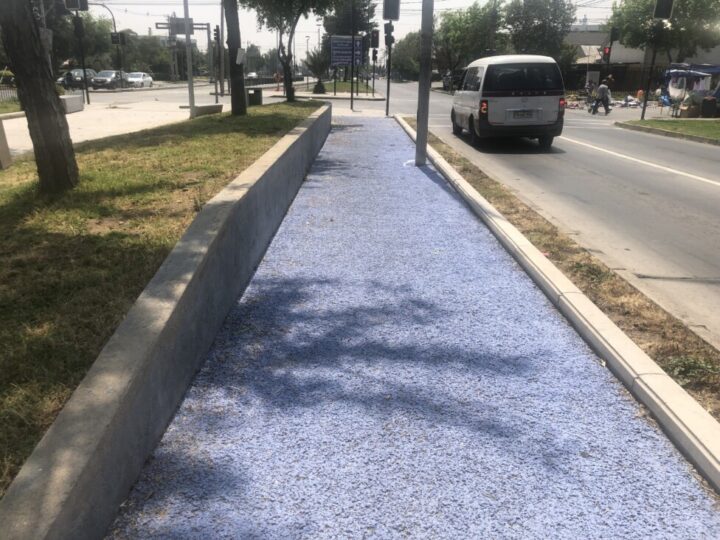
On Las Industrias Avenue, in the south of the Chilean municipality of San Joaquín, a section of the Permeable Pavement project was built, consisting of concrete in a grid pattern that allows water to drain and infiltrate the soil. The project was tested in a sloped bike path area where water can be captured to go directly into the soil. CREDIT: Orlando Milesi / IPS
Water supply initiatives in San Joaquín
The municipality of San Joaquín, population 94,000 located 12 kilometers southwest of the capital, is one of the poorest in the Greater Santiago area.
It is promoting water projects and protecting two parks and will create a third, called the Victor Jara Flood Park, which will be ready by 2025.
“It is the bank of the Zanjón de la Aguada, a canal that is very problematic for Santiago because it received industrial runoff and stank,” said environmental engineer Claudia Silva, in charge of environmental management and control for San Joaquín.
The Flood Park has underground sections and is designed so that, in case of heavy rainfall, it can receive and contain the water. It includes plans for a swimming pool and vegetation on its banks capable of withstanding a flood.
A Rain Garden was created in Mataveri, a street that flooded every time in rained. It consisted of removing cement structures to channel water to plants grown there. And Permeable Pavement, with a reticular pattern, was installed in a bicycle lane to capture water that previously drained into the sewer and thus facilitate its infiltration into the ground.

The Victor Jara Flood Park, to be completed in 2025, covers the municipalities of San Miguel, San Joaquín and Pedro Aguirre Cerda and is promoted by the government of the Metropolitan Region of Santiago. It has underground sections and is designed with plants suitable for areas with heavy water runoff. CREDIT: Orlando Milesi / IPS
The Water Scenarios 2030 study found that another cause of the water crisis is the dispersal of the governance process, with more than 52 institutions at the national level involved in water management.
Díaz also criticized the fact that the measures adopted are heavily oriented towards new sources of water through desalination or accumulation in reservoirs.
“Our view is that we must move towards greener or nature-based solutions in the conservation, restoration and protection of ecosystems involved in the water cycle. Wetlands, swamps, headwaters forests, native trees. This generates a greater impact in terms of water supply, in less time and at a lower cost,” he said.
According to the Chile Foundation expert, the first step is to implement solutions based on nature and then move forward in demand management to reduce water consumption through greater efficiency in agriculture and irrigation of green areas, among other aspects.
“And finally, we must move towards new sources such as the use of treated wastewater or desalination to close the water gap. But nature-based solutions and demand management should address more than 50 percent of the territorial gap in the basins analyzed,” he asserted.

 Print
Print